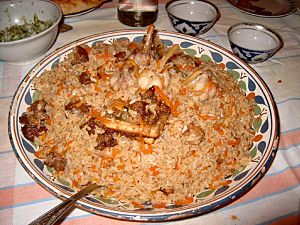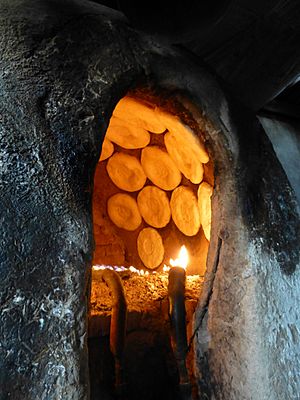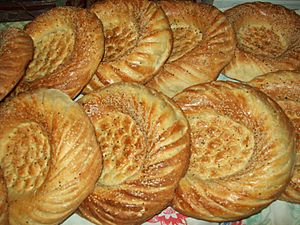Uzbek cuisine facts for kids

Uzbek cuisine shares many cooking traditions with other countries in Central Asia. Uzbekistan grows a lot of grain, so breads and noodles are very important in their food. In fact, Uzbek food is known for having many noodle dishes! Mutton (meat from sheep) is also very popular because there are many sheep in the country. It's used in lots of different Uzbek meals.
Contents
Tasty Uzbek Food
Bread, called nan or non, is a main food item. It's baked in a special oven called a tandur. This oven is often a pot, different from the deep pit ovens used in some other countries. Many types of rice are also eaten. Potatoes were brought to Uzbekistan later, and some older Uzbek people still prefer not to eat them.
The most popular meat is mutton. Beef is also common, but goat meat is rarely eaten. Horse meat is used too, especially in sausages, just like in many other Turkic cultures. Karakul sheep provide meat and also a special fat from their tail, called qurdiuq.
Uzbekistan's most famous dish is palov (also known as plov or osh). This main course is usually made with rice, pieces of meat, shredded carrots, and onions. It's often cooked in a large pot called a kazan over an open fire. Sometimes, chickpeas, raisins, barberries, or other fruits are added to make it different.
While families often cook palov at home, a special chef called an oshpaz makes it for big events like weddings. These chefs cook the dish over an open flame, sometimes serving up to 1,000 people from one huge pot! Nahor oshi, or "morning plov", is a special meal served early in the morning for large groups, often as part of a wedding party.
Other well-known national dishes include:
- Shurpa (or shorva): A soup with large pieces of fatty meat (usually mutton) and fresh vegetables.
- Norin and lagman: These are noodle-based dishes that can be served as a soup or a main meal.
- Manti (also called qasqoni), chuchvara, and somsa: These are dough pockets filled with different ingredients. They can be appetizers or main courses.
- Dimlama: A stew made with meat and vegetables.
- Various kebabs: Grilled meat dishes, usually served as a main course.
Green tea is the national hot drink and is enjoyed all day long. Teahouses (called chaikhanas) are important places for people to gather. In Tashkent, Black tea is preferred. Both types of tea are usually drunk without milk or sugar. Tea is always served with meals and is also offered to every guest as a sign of welcome. Ayran, a cold yogurt drink, is popular in the summer.
Desserts in Uzbek cuisine are usually simple. A special meal often ends with fruit or a compote (a fruit drink). After that, nuts and halvah are served with green tea.
Special Jewish Dishes
The cooking of Bukharan Jews is a unique part of Uzbek cuisine. Their food follows Jewish dietary laws. A very typical Bukharan Jewish dish is oshi sabo. This is a "meal in a pot" that cooks slowly overnight and is eaten hot for Shabbat lunch. Oshi sabo is made with meat, rice, vegetables, and fruit, giving it a special sweet and sour taste.
Other authentic Bukharian Jewish dishes include:
- Osh palov: A version of palov for weekdays, made with both beef and chicken.
- Bakhsh: Called "green palov," this dish has rice with meat or chicken and green herbs like coriander, parsley, and dill.
- Yakhni: A dish with two kinds of boiled meat (beef and chicken), served with a little broth and boiled vegetables.
- Boyjon: An eggplant puree mixed with salt and garlic, often served as a starter.
- Slotah Bukhori: A fresh salad with tomato, cucumber, green onion, cilantro, salt, pepper, and lemon juice.
Popular Uzbek Dishes
Palov Details
Before the 1930s, during the Soviet era, palov was not widely available to everyone. Traditionally, only men cooked this dish. However, when the Soviets took control, women were also allowed to prepare it.
Palov usually starts with meat, often mutton, and vegetables like carrots and onions. These are fried in qurdiuq, the fat from the sheep's tail. The mix of onion and thinly cut carrot is called zirvak. It's similar to a European soffrito. Sometimes, chickpeas and raisins are added. Other ingredients like stuffed grape leaves or poultry can also be used instead of mutton.
The meat is either boiled or fried with the zirvak. The rice is soaked and then placed on top of the other ingredients to steam. This is different from some other ways of making pilaf, where the rice is fried first.
Uzbek Breads

Traditional Uzbek bread is generally called noni or patyr. It's baked as round, flat loaves. They often have a thin, decorated center and a thicker edge. When served, the bread is placed with the decorated side up. People then tear it into pieces and stack them on a plate. Each region has its own types of non. Some of the most famous include:
- Obi non: This is the main bread in Uzbek cooking. Obi nons are even mentioned in the ancient story, the Epic of Gilgamesh. They are baked in clay ovens called tandir.
- Samarkand non: In Samarkand, small, thick obi nons called shirma nons are very popular.
- Bukhara obi non: This bread is often sprinkled with sesame or nigella seeds, giving it a lovely smell.
- Wedding patir: This flaky obi non comes from Andijon and Qashqadaryo. Old traditions say this special bread, made with cream and butter, was served during meetings where marriages were arranged.
- Tashkent lochira: This is a plate-shaped obi non made from a rich dough with milk, butter, and sugar.
Images for kids
-
Tandir kabob - Mutton prepared in the tandir oven
See also
 In Spanish: Gastronomía de Uzbekistán para niños
In Spanish: Gastronomía de Uzbekistán para niños





